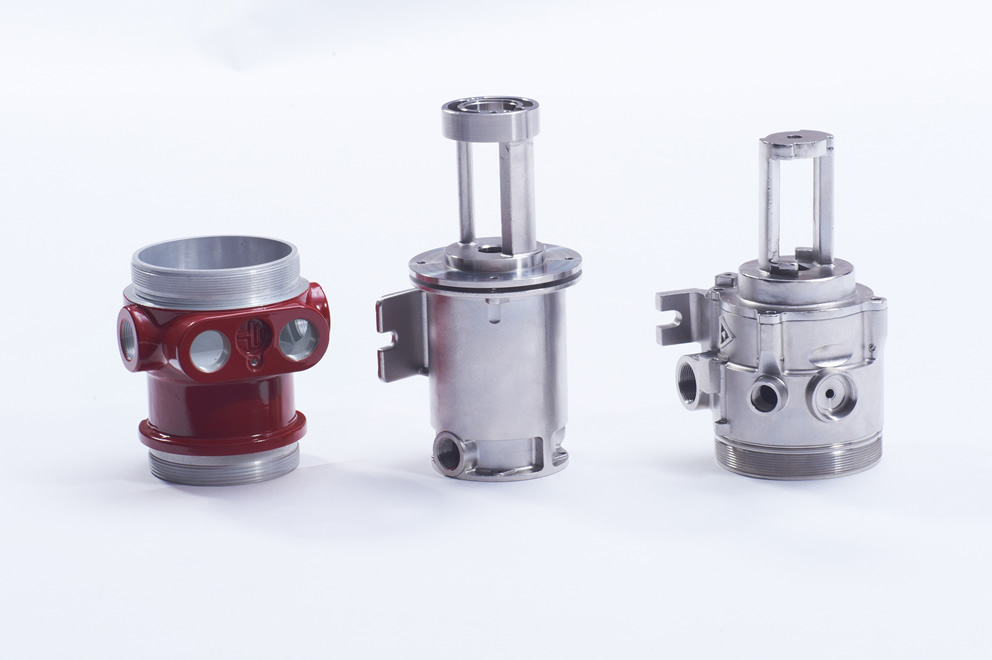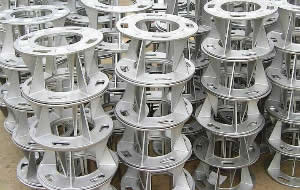Key features that make Precision aluminum casting a top choice in metalworking
Wiki Article
Understanding the Environmental Benefits of Aluminum Factory Techniques
Light weight aluminum foundry techniques play a crucial function in progressing sustainability within the production sector. By carrying out advanced reusing methods and energy-efficient practices, these methods substantially decrease waste and carbon footprints. Ingenious spreading techniques further improve resource conservation initiatives. As markets significantly focus on ecological responsibility, comprehending the complete effect of these techniques ends up being crucial. What certain developments are blazing a trail in this improvement?The Function of Aluminum in Sustainable Manufacturing
Lots of products contribute to sustainable production, light weight aluminum stands out due to its unique residential or commercial properties and recyclability. This lightweight steel is not just durable however likewise possesses superb corrosion resistance, making it an excellent option for different applications, from vehicle to building. Its high strength-to-weight ratio causes power cost savings during transportation and use. Light weight aluminum can be recycled forever without losing its intrinsic top qualities, promoting a round economic climate.The manufacturing procedure of light weight aluminum has evolved, integrating energy-efficient methods that minimize carbon footprints. By using eco-friendly power resources, manufacturers are significantly decreasing the ecological influence connected with aluminum manufacturing. In addition, using recycled aluminum calls for substantially less power contrasted to removing and refining primary light weight aluminum, causing reduced greenhouse gas discharges. As sectors look for lasting remedies, aluminum's adaptability and environmentally friendly qualities placement it as a critical material in the pursuit of greener production techniques.
Advanced Recycling Techniques in Aluminum Foundries
Advanced recycling strategies in light weight aluminum foundries are reinventing the means scrap aluminum is refined and recycled. Cutting-edge techniques, such as closed-loop recycling systems, enable foundries to reclaim aluminum from production waste and out-of-date items successfully. These systems minimize material loss and improve the quality of recycled aluminum, making it a feasible option to key aluminum manufacturing.In addition, advanced arranging innovations, consisting of automated optical sorting and X-ray fluorescence, enhance the separation of aluminum from other products, making sure higher pureness degrees in recycled results. This precision reduces contamination, which can endanger the stability of the end product.
The integration of innovative melting technologies, such as induction melting and energy-efficient heaters, streamlines the reusing process, decreasing power usage. Collectively, these innovations add to a more lasting aluminum industry by reducing reliance on virgin materials and lowering greenhouse gas discharges connected with light weight aluminum manufacturing.
Power Efficiency Improvements in Foundry Workflow
Power effectiveness improvements in aluminum shop procedures can substantially enhance sustainability practices. Carrying out waste heat healing systems enables factories to repurpose excess energy, minimizing general energy usage. Additionally, advancements in process automation simplify operations, resulting in reduced waste and optimized resource use.Waste Warmth Healing
Implementing waste heat healing systems in aluminum factories greatly enhances power performance by recording and recycling excess thermal energy generated during production processes. These systems help with the conversion of squandered heat right into usable energy, which can be made use of for numerous applications within the shop, such as pre-heating products or powering devices. By recuperating heat that would or else be gotten rid of right into the atmosphere, shops can substantially reduce their general energy usage and greenhouse gas discharges. This strategy not only lowers operational prices however additionally promotes sustainable methods within the industry. Additionally, the adoption of waste warmth recovery modern technologies aligns with regulative requirements focused on lowering ecological effect, making it a crucial component of modern light weight aluminum factory operations.Refine Automation Benefits
Automating processes in light weight aluminum foundries can substantially improve power performance by enhancing manufacturing operations and reducing waste. By executing innovative innovations such as robotics and maker knowing, factories can improve operations, reducing unnecessary power intake. Automated systems facilitate accurate control over temperature and material handling, ensuring that energy is made use of just when required. Furthermore, real-time tracking permits instant modifications, decreasing the danger of energy loss. The assimilation of automation not only boosts efficiency but also decreases functional costs, making factories more competitive. Because of this, these energy-efficient methods contribute substantially to sustainability goals, minimizing the environmental footprint of aluminum production while fulfilling increasing market demands - Aluminum Casting Company. Enhanced energy performance via automation stands for a crucial action in the direction of greener factory operationsDecreasing Waste Through Ingenious Casting Methods
Cutting-edge casting techniques play a necessary function in decreasing waste in aluminum foundries. Strategies such as innovative molding and the usage of recyclable materials substantially decrease manufacturing scrap. These techniques not only enhance effectiveness yet likewise add to a more lasting production process.Advanced Molding Techniques
As markets increasingly prioritize sustainability, advanced molding strategies in light weight aluminum shops become reliable options for lowering waste. These cutting-edge approaches, such as 3D printing and accuracy mold and mildew production, significantly improve the efficiency of the casting procedure. By utilizing computer-aided layout (CAD) and simulation innovations, manufacturers can optimize mold geometry, decreasing product usage while preserving item honesty. Furthermore, advanced strategies enable the production of complicated forms that traditional methods can not attain, decreasing the need for added machining and consequently decreasing scrap material. The flexibility of these methods enables rapid prototyping, further reducing lead times and energy consumption. In general, the implementation of sophisticated molding methods stands for an essential action toward ecologically accountable aluminum production, lining up with worldwide sustainability goals.Recyclable Material Utilization
Recyclable materials play an essential function in read more minimizing waste within aluminum shops, changing the spreading landscape with their effective utilization. By including scrap aluminum and other recyclable components right into the original source the production process, foundries can greatly lower the demand for virgin materials. This not just conserves natural deposits however also reduces power intake related to mining and refining. Innovative spreading techniques, such as die spreading and sand spreading, permit smooth integration of these materials, guaranteeing high-grade outputs. The use of recyclable materials cultivates a round economic climate, where resources are constantly reused and repurposed, minimizing garbage dump payments. Ultimately, the calculated use recyclables boosts sustainability while advertising cost-effectiveness in aluminum foundry procedures.Minimizing Production Scrap

Life Cycle Analysis of Aluminum Products
Light weight aluminum is extensively acknowledged for its light-weight and long lasting properties, a complete Life Cycle Analysis (LCA) discloses the environmental influences associated with its manufacturing, disposal, and use. The LCA process checks out the power usage, greenhouse gas discharges, and source depletion connected to aluminum products from extraction of bauxite ore to end-of-life management. Primary light weight aluminum production is energy-intensive, commonly relying upon fossil gas, which adds substantially to carbon footprints. On the other hand, recycling light weight aluminum offers considerable environmental benefits, as it uses only a portion of the power required for key manufacturing. Moreover, the recycling process decreases landfill waste and preserves natural sources. The LCA likewise considers the product's durability and possibility for reuse, stressing the value of lasting style. Generally, understanding the life process effects of light weight aluminum products is crucial for making notified choices that focus on environmental sustainability within the industry.Situation Researches: Effective Sustainable Practices in the Industry
The aluminum sector has actually begun to embrace cutting-edge lasting techniques that attend to the ecological challenges determined in Life process Assessments. One noteworthy instance is a leading foundry that carried out a closed-loop recycling system, considerably reducing waste and energy intake. By recycling scrap light weight aluminum in production, the facility attained browse around this site a 40% reduction in its carbon footprint.An additional example includes a maker that embraced renewable resource sources, powering its operations with solar and wind energy - Aluminum Casting Company. This change not only reduced greenhouse gas exhausts however likewise boosted the business's credibility among ecologically conscious consumers
In addition, a third factory has actually invested in sophisticated casting methods, which maximize material use and reduce flaws, additionally decreasing source consumption. These situation research studies illustrate that the light weight aluminum sector can incorporating lasting methods, demonstrating both environmental responsibility and economic stability, eventually adding to a more lasting future.
Frequently Asked Concerns
Just How Does Aluminum Compare to Various Other Steels in Sustainability?
Aluminum is normally thought about much more lasting than many steels as a result of its recyclability, lower power demands for production, and minimized ecological influence. Its lifecycle performance surpasses that of steel and copper in various applications.What Is the Carbon Footprint of Aluminum Foundry Processes?
The carbon impact of aluminum factory processes differs, commonly varying from 4 to 15 statistics loads of CO2 per lots of aluminum produced. Variables affecting this include energy resources, innovation, and the performance of procedures.Exist Wellness Dangers Connected With Aluminum Foundry Procedures?

What Are the Expenses Related To Lasting Aluminum Techniques?
The prices connected with lasting light weight aluminum methods consist of greater first financial investments in innovation, potential rises in functional costs, and continuous maintenance. These are typically balanced out by lasting financial savings and minimized ecological effect.
Just How Does Aluminum Recycling Effect Resident Communities?
Light weight aluminum reusing positively effects regional communities by developing tasks, lowering landfill waste, and reducing power expenses. It cultivates financial growth and promotes ecological stewardship, leading to much healthier living problems and improved community interaction in sustainability initiatives.In addition, the usage of recycled aluminum requires considerably less power compared to removing and improving main aluminum, leading to reduced greenhouse gas exhausts. Advanced reusing strategies in light weight aluminum foundries are transforming the means scrap light weight aluminum is processed and recycled. Aluminum Foundry. Implementing waste warmth recuperation systems in aluminum foundries greatly improves energy performance by recording and reusing excess thermal energy produced during production processes. Automating procedures in light weight aluminum factories can substantially improve energy efficiency by enhancing production operations and reducing waste. The carbon footprint of aluminum factory processes differs, usually varying from 4 to 15 metric tons of CO2 per load of aluminum generated
Report this wiki page